 Search by Keyword
Sign Up Below for our MONTHLY BEATLES TRIVIA QUIZ!
|
"I'M HAPPY JUST TO DANCE WITH YOU"
(John Lennon - Paul McCartney)
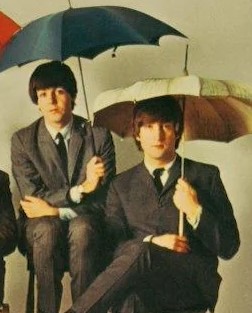 John Lennon and Paul McCartney were especially on top of their game in relation to composing new material for their upcoming first motion picture. As it turned out, this third album was entirely made up of original songs written by the Lennon / McCartney team. No cover songs were needed in order to fill in the gaps because of a lack of original song ideas. And these original ideas were all top-notch; even the ones they considered "hack" songs. John Lennon and Paul McCartney were especially on top of their game in relation to composing new material for their upcoming first motion picture. As it turned out, this third album was entirely made up of original songs written by the Lennon / McCartney team. No cover songs were needed in order to fill in the gaps because of a lack of original song ideas. And these original ideas were all top-notch; even the ones they considered "hack" songs.
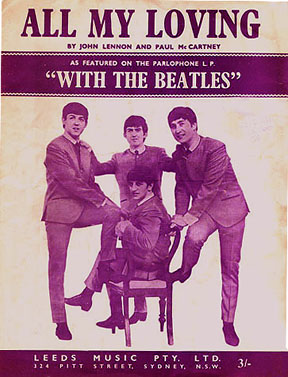 The second of two Lennon / McCartney songs ever given to George Harrison to sing appeared on this album, this being the innocent sounding "I'm Happy Just To Dance With You." ("Do You Want To Know A Secret" was the first, by the way.) While the lyrics may be a throwback to the shallow teenage romanticism heard in "I Want To Hold Your Hand" and "All My Loving," the musicianship was anything but simple. In fact, this fast-paced roller-coaster-ride of a song skids its way through turn after turn with an incredible amount of chord changes and melody lines until it finally leaves us breathless at the final resolving chord. And all this in just under two minutes! The second of two Lennon / McCartney songs ever given to George Harrison to sing appeared on this album, this being the innocent sounding "I'm Happy Just To Dance With You." ("Do You Want To Know A Secret" was the first, by the way.) While the lyrics may be a throwback to the shallow teenage romanticism heard in "I Want To Hold Your Hand" and "All My Loving," the musicianship was anything but simple. In fact, this fast-paced roller-coaster-ride of a song skids its way through turn after turn with an incredible amount of chord changes and melody lines until it finally leaves us breathless at the final resolving chord. And all this in just under two minutes!
Songwriting History
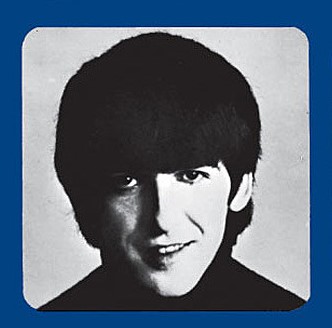 "That was written for George to give him a piece of the action." This quote from John Lennon confirms the true intention of the song, which was to provide their lead guitarist a vocal piece in their first film "A Hard Day's Night." George Harrison was just then developing as a songwriter, the group having recently recorded his first song, titled "Don't Bother Me," for their second British album "With The Beatles." "That was written for George to give him a piece of the action." This quote from John Lennon confirms the true intention of the song, which was to provide their lead guitarist a vocal piece in their first film "A Hard Day's Night." George Harrison was just then developing as a songwriter, the group having recently recorded his first song, titled "Don't Bother Me," for their second British album "With The Beatles."
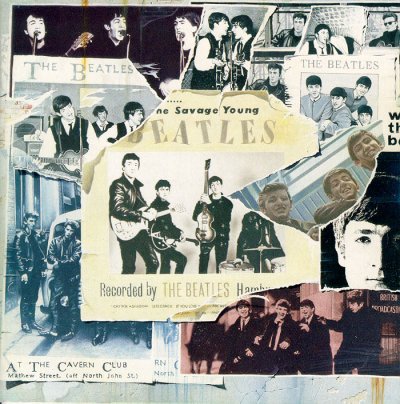 George was in the process of writing another song entitled "You Know What To Do" but since it was slow in coming, John and Paul wrote one for him. In a 1965 interview George confessed this about his songwriting: "It will probably take me about three months before I finish one song. I'm so lazy it's ridiculous." As for "You Know What To Do," it only got as far as the demo stage, which you can hear on the "Anthology 1" album. George was in the process of writing another song entitled "You Know What To Do" but since it was slow in coming, John and Paul wrote one for him. In a 1965 interview George confessed this about his songwriting: "It will probably take me about three months before I finish one song. I'm so lazy it's ridiculous." As for "You Know What To Do," it only got as far as the demo stage, which you can hear on the "Anthology 1" album.
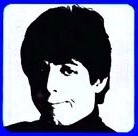 As for the song for the film, Paul McCartney elaborates further. "We wrote 'I'm Happy Just To Dance With You' for George in the film. It was a bit of a formula song. We knew that in (the key of) E if you went to an A-flat minor, you could always make a song with those chords: that change pretty much always excited you. This was one of these...This one anyway was a straight co-written song for George." As for the song for the film, Paul McCartney elaborates further. "We wrote 'I'm Happy Just To Dance With You' for George in the film. It was a bit of a formula song. We knew that in (the key of) E if you went to an A-flat minor, you could always make a song with those chords: that change pretty much always excited you. This was one of these...This one anyway was a straight co-written song for George."
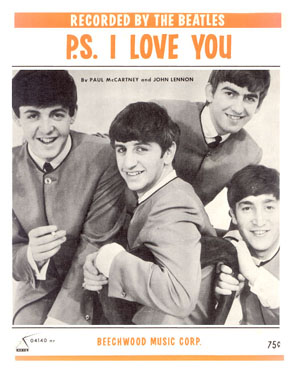 Neither John nor Paul had any intention of singing it themselves. "I couldn'ta sung it," stated Lennon. Paul explains the reason why in the 1997 biography "Many Years From Now," stating: "We wouldn't have actually wanted to sing it because it was a bit...The ones that pandered to the fans in truth were our least favorite songs but they were good. They were very good for the time." Both Lennon and McCartney were progressing past lyric writing specifically designed for teenage girl fans, such as "From Me To You," "Thank You Girl" and "P.S. I Love You." But for the sake of cranking out another song needed for the movie, and to give Harrison one to sing, they reverted back to this practice sometime in February of 1964, for one of the last times in their career. Neither John nor Paul had any intention of singing it themselves. "I couldn'ta sung it," stated Lennon. Paul explains the reason why in the 1997 biography "Many Years From Now," stating: "We wouldn't have actually wanted to sing it because it was a bit...The ones that pandered to the fans in truth were our least favorite songs but they were good. They were very good for the time." Both Lennon and McCartney were progressing past lyric writing specifically designed for teenage girl fans, such as "From Me To You," "Thank You Girl" and "P.S. I Love You." But for the sake of cranking out another song needed for the movie, and to give Harrison one to sing, they reverted back to this practice sometime in February of 1964, for one of the last times in their career.
As for their opinion of the song, in "Many Years From Now," McCartney adds: "The nice thing about it was to actually pull a song off on a slim little premise like that. A simple little idea. It was songwriting practice."
Recording History
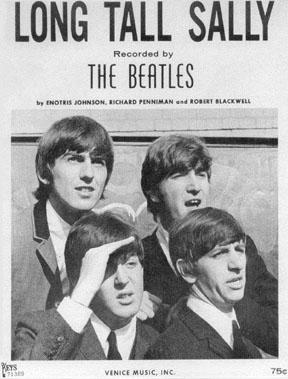 "I'm Happy Just To Dance With You" turned out to be the last soundtrack song The Beatles recorded for "A Hard Day's Night" before shooting for the movie commenced on March 2nd, 1964. The day before, on March 1st, the group met in EMI Studio Two for a three-and-a-half hour recording session to finish up the full requisite of songs for potential inclusion in their first film. "I'm Happy Just To Dance With You" turned out to be the last soundtrack song The Beatles recorded for "A Hard Day's Night" before shooting for the movie commenced on March 2nd, 1964. The day before, on March 1st, the group met in EMI Studio Two for a three-and-a-half hour recording session to finish up the full requisite of songs for potential inclusion in their first film.
This session, which ran from 10 am to 1:30 pm, saw three songs through from start to finish; although the second two songs recorded on this day ("Long Tall Sally" and "I Call Your Name") ended up not making it into the movie, instead being held over for release as a British EP on June 19th, 1964.
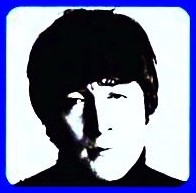 Another unique aspect of this recording session was that it was held on a Sunday. This was the first Sunday recording session ever scheduled for The Beatles, no doubt because it was the very last day available to record songs for the movie. The occurence of Sunday recording sessions became much more commonplace from this point forward. Another unique aspect of this recording session was that it was held on a Sunday. This was the first Sunday recording session ever scheduled for The Beatles, no doubt because it was the very last day available to record songs for the movie. The occurence of Sunday recording sessions became much more commonplace from this point forward.
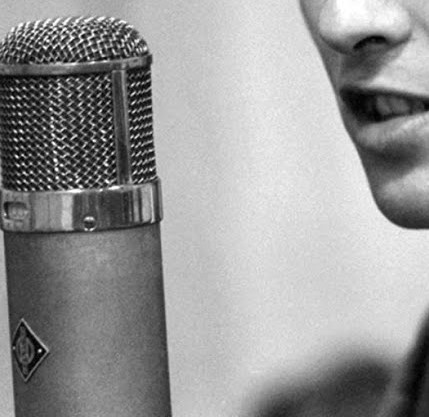 "I'm Happy Just To Dance With You" was the first to be tackled at 10 am, with the first three takes concentrating solely on the rhythm track. The intention may have been to add vocals as overdubs later, which is something that became common practice for the group in 1965. As it came to be, though, after two full instrumental takes and one false start ("take three"), vocals were introduced for the first time on "take four." This was the take onto which overdubs were applied, these consisting of George double-tracking his vocals, John and Paul contributing harmonized background vocals, and Ringo thumping on a loose-skinned Arabian drum during the verses. By approximately 11 am the song was complete. "I'm Happy Just To Dance With You" was the first to be tackled at 10 am, with the first three takes concentrating solely on the rhythm track. The intention may have been to add vocals as overdubs later, which is something that became common practice for the group in 1965. As it came to be, though, after two full instrumental takes and one false start ("take three"), vocals were introduced for the first time on "take four." This was the take onto which overdubs were applied, these consisting of George double-tracking his vocals, John and Paul contributing harmonized background vocals, and Ringo thumping on a loose-skinned Arabian drum during the verses. By approximately 11 am the song was complete.
 Mono mixing for the song occurred two days later on March 3rd in the control room of EMI Studio One with producer George Martin and engineers Norman Smith and A.B. Lincoln all in attendance. All of the songs being considered for the film were mixed on this day and given to United Artists to choose from. Take four of the song was used for this mix, which also appeared as the mono version made available worldwide. Mono mixing for the song occurred two days later on March 3rd in the control room of EMI Studio One with producer George Martin and engineers Norman Smith and A.B. Lincoln all in attendance. All of the songs being considered for the film were mixed on this day and given to United Artists to choose from. Take four of the song was used for this mix, which also appeared as the mono version made available worldwide.
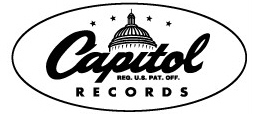 On June 9th, 1964, mono tape copies of all the movie songs were prepared, to be distributed to both US record labels that were releasing them, United Artists for the soundtrack album and Capitol Records for single release and their makeshift album "Something New." This tape copying happened in the EMI Studio Three control room with only George Martin, Norman Smith and 2nd engineer Ken Scott in attendance. On June 9th, 1964, mono tape copies of all the movie songs were prepared, to be distributed to both US record labels that were releasing them, United Artists for the soundtrack album and Capitol Records for single release and their makeshift album "Something New." This tape copying happened in the EMI Studio Three control room with only George Martin, Norman Smith and 2nd engineer Ken Scott in attendance.
 The stereo mix of the song was prepared during a hectic full-day at EMI studios on June 22nd, 1964 by George Martin, Norman Smith and 2nd engineer Geoff Emerick. The rushed atmosphere on this marathon eleven-hour session resulted in a stereo mix of "I'm Happy Just To Dance With You" with an overly emphasized Arabian drum overdub from Ringo, which unfortunately comes across unnaturally loud. However, this is the stereo mix made available around the world in 1964. The stereo mix of the song was prepared during a hectic full-day at EMI studios on June 22nd, 1964 by George Martin, Norman Smith and 2nd engineer Geoff Emerick. The rushed atmosphere on this marathon eleven-hour session resulted in a stereo mix of "I'm Happy Just To Dance With You" with an overly emphasized Arabian drum overdub from Ringo, which unfortunately comes across unnaturally loud. However, this is the stereo mix made available around the world in 1964.
.jpg) The Beatles then recorded another version of this song on July 17th, 1964 at BBC Paris Studio in London between 2:15 and 6:15 pm for the fourth edition of the BBC radio show "From Us To You." This new recording, which was produced by Bryant Marriott and aired on August 3rd between 10 am and 12 noon, showed that the group was now taking a little more time for BBC recordings, the engineering staff actually double-tracking George's vocals, even though he interchanges different lines in the lyrics here and there. The Beatles then recorded another version of this song on July 17th, 1964 at BBC Paris Studio in London between 2:15 and 6:15 pm for the fourth edition of the BBC radio show "From Us To You." This new recording, which was produced by Bryant Marriott and aired on August 3rd between 10 am and 12 noon, showed that the group was now taking a little more time for BBC recordings, the engineering staff actually double-tracking George's vocals, even though he interchanges different lines in the lyrics here and there.
Song Structure and Style
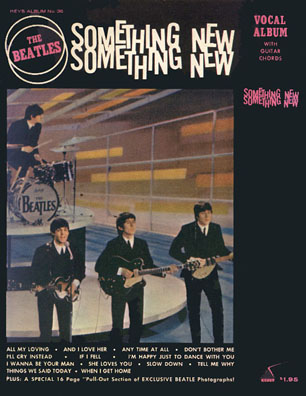 Although Lennon and McCartney used it sparingly, they here incorporated a songwriting formula that included a refrain. Taking the lead from familiar songs like "A Taste Of Honey," they worked with a refrain as early as 1963 in "All My Loving" and "All I've Got To Do." They resurrect this formula here again, but then complicate it a bit by using a 'refrain/ verse/ verse/ refrain/ verse/ refrain/ verse/ alternate refrain' pattern. This would therefore become an abbababc pattern. Although Lennon and McCartney used it sparingly, they here incorporated a songwriting formula that included a refrain. Taking the lead from familiar songs like "A Taste Of Honey," they worked with a refrain as early as 1963 in "All My Loving" and "All I've Got To Do." They resurrect this formula here again, but then complicate it a bit by using a 'refrain/ verse/ verse/ refrain/ verse/ refrain/ verse/ alternate refrain' pattern. This would therefore become an abbababc pattern.
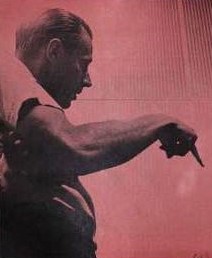 It was undoubtedly George Martin's suggestion to begin with the eight measure refrain, which here dispenses with all vocals until the fifth measure where we hear only the lead vocal reappear. Every refrain (even this altered one) features an accent on the 'two-and' off beat of the second and fourth measures which acts as "pushes" throughout the song. Ringo introduces each of these "pushes" with a small drum roll, or at least he does when he remembers to do so. It was undoubtedly George Martin's suggestion to begin with the eight measure refrain, which here dispenses with all vocals until the fifth measure where we hear only the lead vocal reappear. Every refrain (even this altered one) features an accent on the 'two-and' off beat of the second and fourth measures which acts as "pushes" throughout the song. Ringo introduces each of these "pushes" with a small drum roll, or at least he does when he remembers to do so.
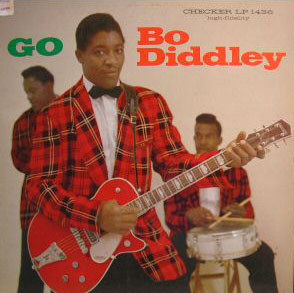 The first verse introduces a fast-paced rhythm guitar pattern reminiscent of Bo Diddley, while Harrison handles the vocals entirely by himself. The melody lines of every verse consist primarily of eighth notes, this propelling the song somewhat quickly into the lyrical hook-line of the song's title at the end of each verse. The "pushes" that are accentuated in the refrain are previewed here by Ringo's overdubbed Arabian drum accents on the 'one' and 'one-and' beat of each measure of the verses. The first verse introduces a fast-paced rhythm guitar pattern reminiscent of Bo Diddley, while Harrison handles the vocals entirely by himself. The melody lines of every verse consist primarily of eighth notes, this propelling the song somewhat quickly into the lyrical hook-line of the song's title at the end of each verse. The "pushes" that are accentuated in the refrain are previewed here by Ringo's overdubbed Arabian drum accents on the 'one' and 'one-and' beat of each measure of the verses.
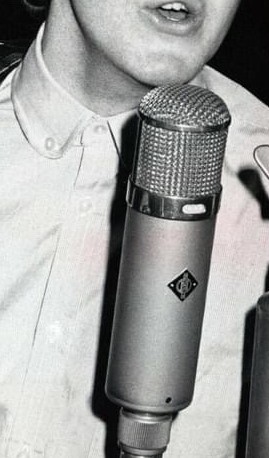 After the second verse is heard, we're taken directly into the first proper refrain, which premiers John and Paul's background vocals for the first time. Their "oh-oh" backing vocals are almost too intrusive on George's lead vocals, but end up working nicely as a compliment to them. After the second verse is heard, we're taken directly into the first proper refrain, which premiers John and Paul's background vocals for the first time. Their "oh-oh" backing vocals are almost too intrusive on George's lead vocals, but end up working nicely as a compliment to them.
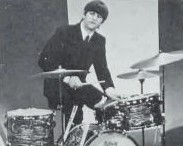 The 'verse/ refrain/ verse' pattern continues until we reach what we would expect to be another refrain. This becomes an "alternate refrain" that is used for the song's conclusion. The final line of the final verse changes from the song's title to "I've discovered I'm in love with you." The word "you," which is usually where the eighth measure of the verse begins becomes the beginning of the seven-measure "alternate refrain." After the title of the song finally appears, we hear a doubly repeated set of "oh-oh" background vocals before the climactic resolution in the home key. And now we can finally breathe. The 'verse/ refrain/ verse' pattern continues until we reach what we would expect to be another refrain. This becomes an "alternate refrain" that is used for the song's conclusion. The final line of the final verse changes from the song's title to "I've discovered I'm in love with you." The word "you," which is usually where the eighth measure of the verse begins becomes the beginning of the seven-measure "alternate refrain." After the title of the song finally appears, we hear a doubly repeated set of "oh-oh" background vocals before the climactic resolution in the home key. And now we can finally breathe.
 George Harrison did quite well in maintaining good pitch despite the fast-paced melody lines. George Martin opted to maintain double-tracking on his voice throughout the song in both the mono and stereo mixes of the song, which is different from many of the other tracks on the soundtrack where he faded in the double-tracking sparingly for needed effect (see "Tell Me Why," "And I Love Her" and "If I Fell"). George Harrison did quite well in maintaining good pitch despite the fast-paced melody lines. George Martin opted to maintain double-tracking on his voice throughout the song in both the mono and stereo mixes of the song, which is different from many of the other tracks on the soundtrack where he faded in the double-tracking sparingly for needed effect (see "Tell Me Why," "And I Love Her" and "If I Fell").
 McCartney's bass work is next to be commended because of its intricate counter-melody skillfully woven between the fast-moving multiple chord changes throughout the song. His high background harmonies are also "spot on" as usual which, paired with Lennon's lower harmonies, creates a suitable counter-melody in itself. Adding a touch of reverb to all of this vocal work sets this off quite nicely against the otherwise dry recording. McCartney's bass work is next to be commended because of its intricate counter-melody skillfully woven between the fast-moving multiple chord changes throughout the song. His high background harmonies are also "spot on" as usual which, paired with Lennon's lower harmonies, creates a suitable counter-melody in itself. Adding a touch of reverb to all of this vocal work sets this off quite nicely against the otherwise dry recording.
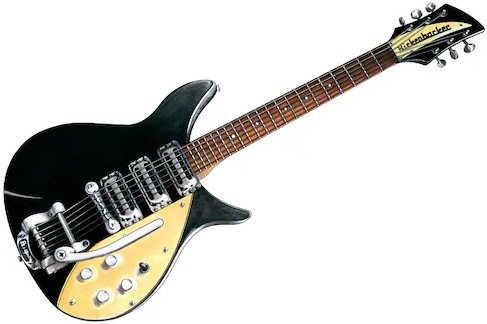 John Lennon's Bo Diddley-esque rhythm guitar work, although a little heavy-handed and behind the beat at times, adds a sophisticated feel to the song as well as propelling it to a rocket's pace. It's quite apparent that, for a song viewed by some as a "throwaway," a lot of thought and rehearsal went into it. John Lennon's Bo Diddley-esque rhythm guitar work, although a little heavy-handed and behind the beat at times, adds a sophisticated feel to the song as well as propelling it to a rocket's pace. It's quite apparent that, for a song viewed by some as a "throwaway," a lot of thought and rehearsal went into it.
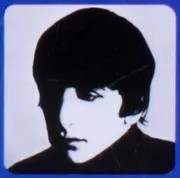 It seems that Ringo is the only one going along for the ride on this song. He follows instructions by performing his accented 'pushes' in the song's introductions, but fails to remember to include them later, such as during the second refrain. He even seems to be fumbling for where these accents go in the conclusion of the song; at first performing it in the fourth measure instead of the fifth, then just stopping in the fifth where he should have put the accent, then finally getting it right by the sixth measure. Usually Ringo is on top of his game but, obviously on this occasion, he wasn't yet familiar enough with the song. And, because this was the last day available for recording before filming started, it was deemed 'good enough'. It seems that Ringo is the only one going along for the ride on this song. He follows instructions by performing his accented 'pushes' in the song's introductions, but fails to remember to include them later, such as during the second refrain. He even seems to be fumbling for where these accents go in the conclusion of the song; at first performing it in the fourth measure instead of the fifth, then just stopping in the fifth where he should have put the accent, then finally getting it right by the sixth measure. Usually Ringo is on top of his game but, obviously on this occasion, he wasn't yet familiar enough with the song. And, because this was the last day available for recording before filming started, it was deemed 'good enough'.
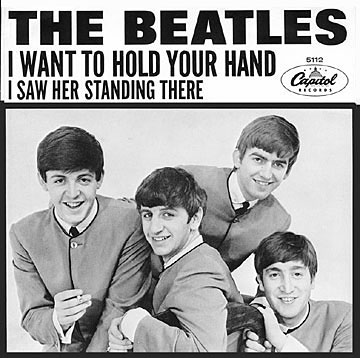 As stated earlier, the lyrical subject matter was a throwback to the teenage romanticism heard in earlier songs like "I Want To Hold Your Hand." (Interestingly, the first line of the first verse of this song states "I don't want to...hold your hand.") Being that Lennon was delving into more realism in his lyric writing at this time, we can see why he wouldn't have wanted to sing this one. His extra-marital escapades of these early years are very well documented; therefore he wasn't at all happy just to dance with someone he was interested in. As stated earlier, the lyrical subject matter was a throwback to the teenage romanticism heard in earlier songs like "I Want To Hold Your Hand." (Interestingly, the first line of the first verse of this song states "I don't want to...hold your hand.") Being that Lennon was delving into more realism in his lyric writing at this time, we can see why he wouldn't have wanted to sing this one. His extra-marital escapades of these early years are very well documented; therefore he wasn't at all happy just to dance with someone he was interested in.
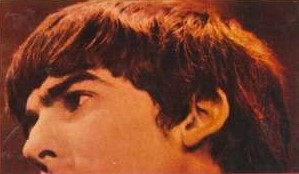 Harrison's doleful vocal performance conveys the lyrics convincingly for the most part, showing an innocent desire to dance with someone, that being 'everything he needs' and nothing more. Even the woman questions his sincerity, which then suggests the lyric "There is really nothing else I'd rather do." The only lines that can make your eyes roll are the ones that unrealistically state that "before this dance is through I guess I'll love you too." They even take that idea further by making the pay-off line of the song "I've discovered I'm in love with you 'cause I'm happy just to dance with you." Only heart-sick teenyboppers in the '60s would find this feasible. Harrison's doleful vocal performance conveys the lyrics convincingly for the most part, showing an innocent desire to dance with someone, that being 'everything he needs' and nothing more. Even the woman questions his sincerity, which then suggests the lyric "There is really nothing else I'd rather do." The only lines that can make your eyes roll are the ones that unrealistically state that "before this dance is through I guess I'll love you too." They even take that idea further by making the pay-off line of the song "I've discovered I'm in love with you 'cause I'm happy just to dance with you." Only heart-sick teenyboppers in the '60s would find this feasible.
 However, when these lyrics are sung as a ballad, as in the case of Anne Murray's 1980 rendition, the sentiment takes on a much more convincing tone. In fact, the beauty of the melody comes to the fore, making us realize all the more so what great songwriters Lennon and McCartney were, even when they weren't trying so hard. However, when these lyrics are sung as a ballad, as in the case of Anne Murray's 1980 rendition, the sentiment takes on a much more convincing tone. In fact, the beauty of the melody comes to the fore, making us realize all the more so what great songwriters Lennon and McCartney were, even when they weren't trying so hard.
 United Artists Records' Soundtrack Album
|
American Releases
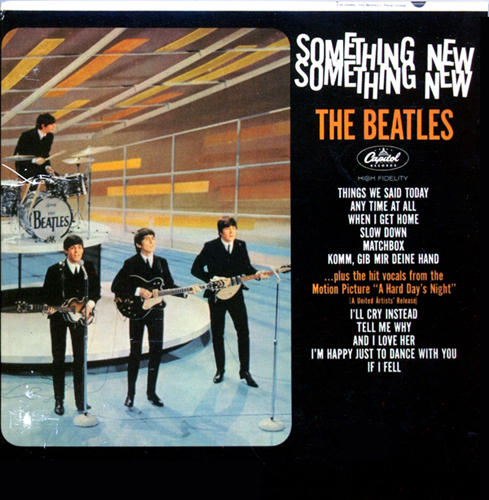 June 26th, 1964, was the date that United Artists Records rush-released their soundtrack album for "A Hard Day's Night." This fast-selling platinum album was America's first glimpse of "I'm Happy Just To Dance With You." Since United Artists was anxious to release this album, and they only had the mono mixes sent to them from EMI around June 10th, 1964, they created a "High Fidelity Stereo" mix of the song for their stereo pressings from this mono mix. They created two seperate channels of the mono mix and boosted the bass frequencies for the left channel and raised the treble frequencies for the right channel, thus creating the illusion of stereo for the listener. United Artists kept this album in print until the label was purchased by Capitol Records in 1978, Capitol beginning their reprints of this soundtrack album on August 1st, 1980. The American soundtrack album, however, got its compact disc release on January 21st, 2014, both the mono and stereo versions of the album being contained on a single CD. June 26th, 1964, was the date that United Artists Records rush-released their soundtrack album for "A Hard Day's Night." This fast-selling platinum album was America's first glimpse of "I'm Happy Just To Dance With You." Since United Artists was anxious to release this album, and they only had the mono mixes sent to them from EMI around June 10th, 1964, they created a "High Fidelity Stereo" mix of the song for their stereo pressings from this mono mix. They created two seperate channels of the mono mix and boosted the bass frequencies for the left channel and raised the treble frequencies for the right channel, thus creating the illusion of stereo for the listener. United Artists kept this album in print until the label was purchased by Capitol Records in 1978, Capitol beginning their reprints of this soundtrack album on August 1st, 1980. The American soundtrack album, however, got its compact disc release on January 21st, 2014, both the mono and stereo versions of the album being contained on a single CD.
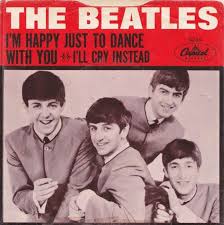 Capitol Records was quick to make sure we all knew the song as well. Less than a month later, on July 20th, Capitol released their third Beatles album "Something New," which featured the song as well. This album was also released on an individual compact disc on January 21st, 2014, both the mono and stereo versions being contained on one CD. Also on the same date, they released the single "I'll Cry Instead" with "I'm Happy Just To Dance With You" as its b-side, which briefly charted on its own for one week at #95 on the Billboard Hot 100. Capitol Records was quick to make sure we all knew the song as well. Less than a month later, on July 20th, Capitol released their third Beatles album "Something New," which featured the song as well. This album was also released on an individual compact disc on January 21st, 2014, both the mono and stereo versions being contained on one CD. Also on the same date, they released the single "I'll Cry Instead" with "I'm Happy Just To Dance With You" as its b-side, which briefly charted on its own for one week at #95 on the Billboard Hot 100.
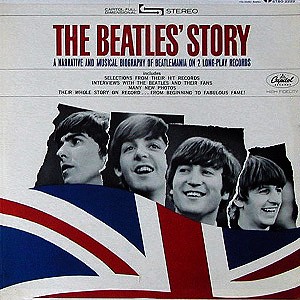 A segment of the song was also included on the track "Beatle Medley" on the documentary double LP "The Beatles' Story," which was released by Capitol Records on November 23rd, 1964. Surprisingly, this album was also released on compact disc on January 21st, 2014, but only as contained in the 13 album box set "The US Albums." A segment of the song was also included on the track "Beatle Medley" on the documentary double LP "The Beatles' Story," which was released by Capitol Records on November 23rd, 1964. Surprisingly, this album was also released on compact disc on January 21st, 2014, but only as contained in the 13 album box set "The US Albums."
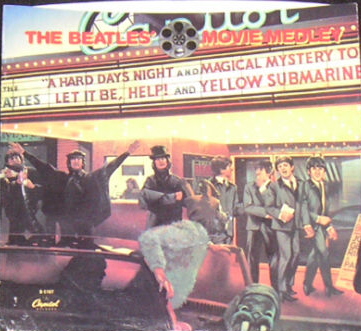 The song continued its b-side role in 1982 as the flip-side to the successful hit single "The Beatles Movie Medley," which was released on March 22nd, 1982 and reached #12 on the Billboard Hot 100. The a-side featured snippets of songs from all five Beatles movies (including "Magical Mystery Tour") edited cohesively together. The b-side originally was an interview with The Beatles about the making of "A Hard Day's Night" but, because Capitol couldn't get the proper clearance, they replaced it with "I'm Happy Just To Dance With You." Original copies with the interview b-side are quite the find today, while the single with "I'm Happy Just To Dance With You" as the b-side was included in the vinyl box set "The Beatles Singles Collection" that was released on December 6th, 1982. The song continued its b-side role in 1982 as the flip-side to the successful hit single "The Beatles Movie Medley," which was released on March 22nd, 1982 and reached #12 on the Billboard Hot 100. The a-side featured snippets of songs from all five Beatles movies (including "Magical Mystery Tour") edited cohesively together. The b-side originally was an interview with The Beatles about the making of "A Hard Day's Night" but, because Capitol couldn't get the proper clearance, they replaced it with "I'm Happy Just To Dance With You." Original copies with the interview b-side are quite the find today, while the single with "I'm Happy Just To Dance With You" as the b-side was included in the vinyl box set "The Beatles Singles Collection" that was released on December 6th, 1982.
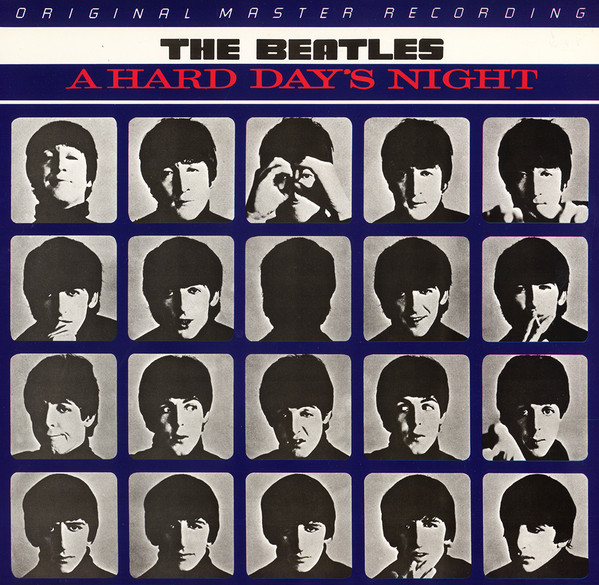 The first time the original British "A Hard Day's Night" album was made available in the US was the "Original Master Recording" vinyl edition released through Mobile Fidelity Sound Lab in February of 1987. This album included "I'm Happy Just To Dance With You" and was prepared utilizing half-speed mastering technology from the original master tape on loan from EMI. This version of the album was only available for a short time and is quite collectible today. The first time the original British "A Hard Day's Night" album was made available in the US was the "Original Master Recording" vinyl edition released through Mobile Fidelity Sound Lab in February of 1987. This album included "I'm Happy Just To Dance With You" and was prepared utilizing half-speed mastering technology from the original master tape on loan from EMI. This version of the album was only available for a short time and is quite collectible today.
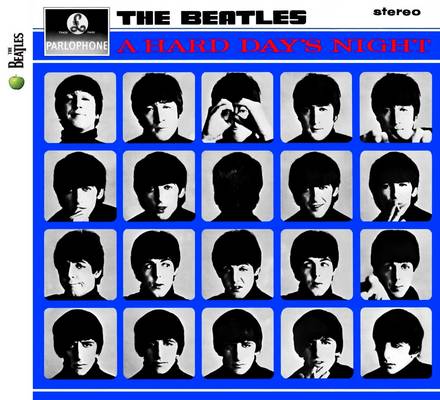 February 26th, 1987 saw the original "A Hard Day's Night" album released in mono in the compact disc format, a vinyl edition coming out on July 21st, 1987. It was released in stereo on the remastered version that came out on CD on September 9th, 2009 and on vinyl on November 13th, 2012. February 26th, 1987 saw the original "A Hard Day's Night" album released in mono in the compact disc format, a vinyl edition coming out on July 21st, 1987. It was released in stereo on the remastered version that came out on CD on September 9th, 2009 and on vinyl on November 13th, 2012.
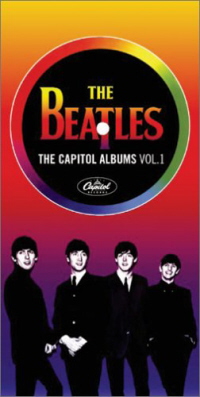 On November 15th, 2004, the box set “The Capitol Albums, Volume 1” was released, which features both the original stereo and mono mixes as originally heard on the album “Something New.” On November 15th, 2004, the box set “The Capitol Albums, Volume 1” was released, which features both the original stereo and mono mixes as originally heard on the album “Something New.”
A striking remastered mono mix of “I’m Happy Just To Dance With You” appears on the CD box set “The Beatles In Mono,” which was released on September 9th, 2009, the vinyl edition coming out on September 9th, 2014.
Live Performances
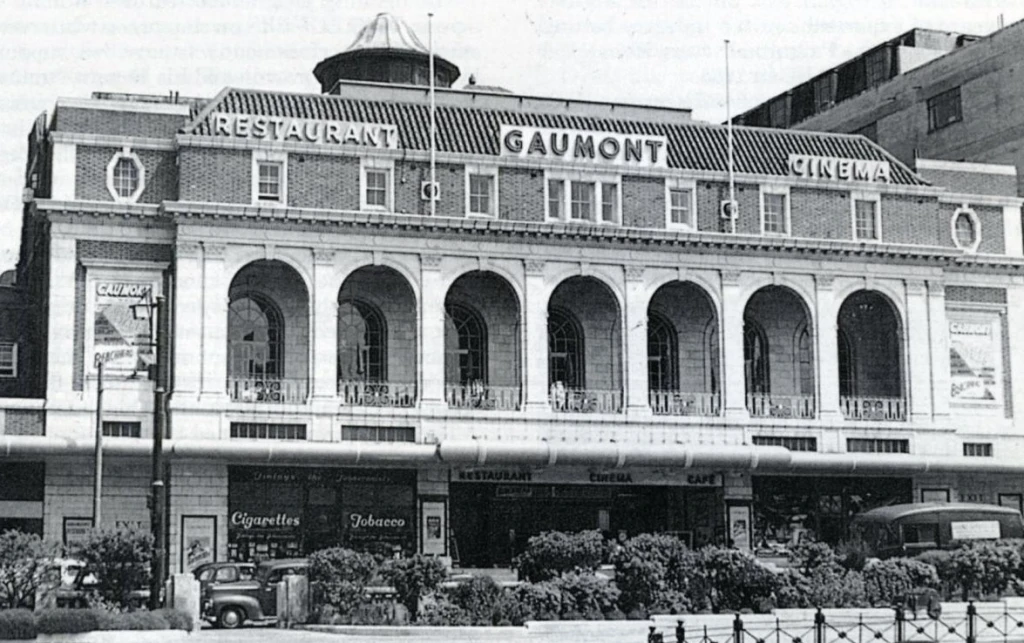 The song did have a brief performance history in 1964. Other than the mimed sequence for the song in the film, their brief British tour in the fall of 1964 also featured the song as the spotlight for George in the set list. This tour, which comprised two performances per date, ran from October 9th (at Gaumont Cinema in Bradford) to November 10th (at Colston Hall in Bristol). For the remainder of 1964, George's feature song switched to the recently released "Everybody's Trying To Be My Baby." The song did have a brief performance history in 1964. Other than the mimed sequence for the song in the film, their brief British tour in the fall of 1964 also featured the song as the spotlight for George in the set list. This tour, which comprised two performances per date, ran from October 9th (at Gaumont Cinema in Bradford) to November 10th (at Colston Hall in Bristol). For the remainder of 1964, George's feature song switched to the recently released "Everybody's Trying To Be My Baby."
Conclusion
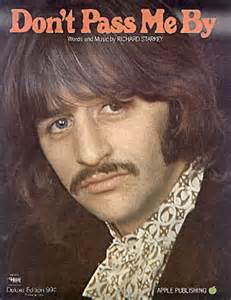 Since this was the last time that Lennon and McCartney had to supply a song for George Harrison to sing, they could now breathe a little easier. George stepped up his songwriting game from 1965 on, submitting two songs for both albums released that year, so he never was at any loss for new material. All that John and Paul had to worry about now was preparing songs for Ringo since he also had a legion of fans, especially in America. Even though he tried his hand at being a composer as early as 1963, his first self-penned song "Don't Pass Me By" didn't appear until 1968. Since this was the last time that Lennon and McCartney had to supply a song for George Harrison to sing, they could now breathe a little easier. George stepped up his songwriting game from 1965 on, submitting two songs for both albums released that year, so he never was at any loss for new material. All that John and Paul had to worry about now was preparing songs for Ringo since he also had a legion of fans, especially in America. Even though he tried his hand at being a composer as early as 1963, his first self-penned song "Don't Pass Me By" didn't appear until 1968.
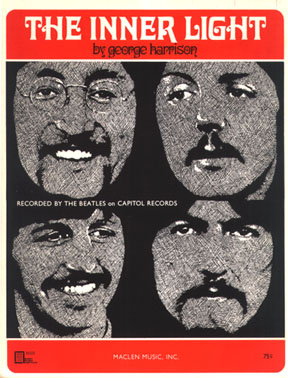 The development of George as a songwriter was something that we all could witness as it progressed. His lyrical negativity ("Don't Bother Me," "Think For Yourself") turned observably more positive with time ("Long, Long, Long," "Here Comes The Sun"). Harrison's downbeat chord structures and melodic lines ("Taxman," "Love You To") became much more major and upbeat as well ("For You Blue," "Something"). And son't forget his foray into Indian influences ("Within You, Without You," "The Inner Light"). The development of George as a songwriter was something that we all could witness as it progressed. His lyrical negativity ("Don't Bother Me," "Think For Yourself") turned observably more positive with time ("Long, Long, Long," "Here Comes The Sun"). Harrison's downbeat chord structures and melodic lines ("Taxman," "Love You To") became much more major and upbeat as well ("For You Blue," "Something"). And son't forget his foray into Indian influences ("Within You, Without You," "The Inner Light").
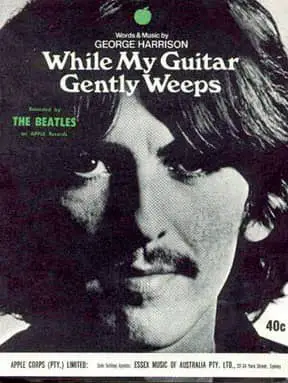 Only with hindsight can we see the personality Harrison displayed through his songs. Not being able to use this as foreknowledge, John and Paul wrote specifically for what they perceived at the time to be his image among fans. Therefore they arrived at "I'm Happy Just To Dance With You" with its limited vocal range and the adolescent quality of the lyrics. As everyone can now acknowledge, George Harrison did possess the capability of expressing himself with much more aplomb. Only with hindsight can we see the personality Harrison displayed through his songs. Not being able to use this as foreknowledge, John and Paul wrote specifically for what they perceived at the time to be his image among fans. Therefore they arrived at "I'm Happy Just To Dance With You" with its limited vocal range and the adolescent quality of the lyrics. As everyone can now acknowledge, George Harrison did possess the capability of expressing himself with much more aplomb.
Song Summary
"I'm Happy Just To Dance With You"
Written by: John Lennon / Paul McCartney
Instrumentation (most likely):
- George Harrison - Lead Vocals, Rhythm Guitar (1963 Rickenbacker 360-12 Fire-glo)
- John Lennon - Rhythm Guitar (1964 Rickenbacker 325), backing vocals
- Paul McCartney - Bass Guitar (1963 Hofner 500/1), backing vocals
- Ringo Starr - Drums (1963 Ludwig Downbeat Black Oyster Pearl), Arabian drum
Written and compiled by Dave Rybaczewski
|
IF YOU WOULD LIKE TO MAKE A DONATION TO KEEP THIS WEBSITE UP AND RUNNING, PLEASE CLICK BELOW!
|